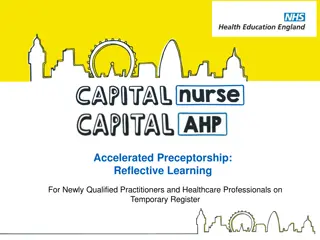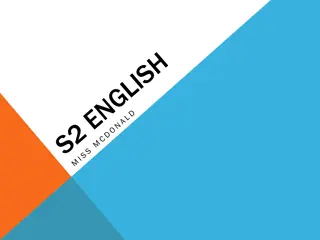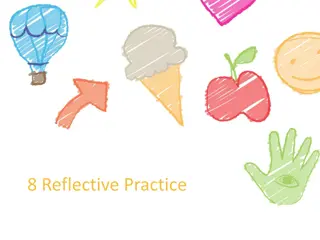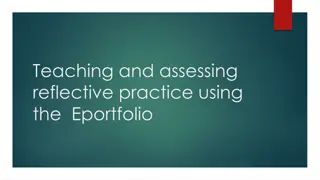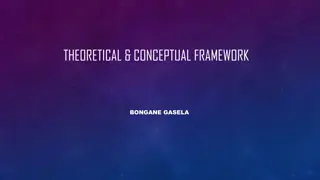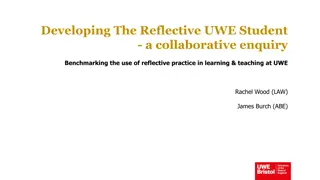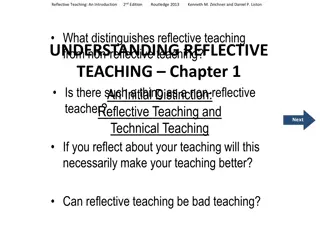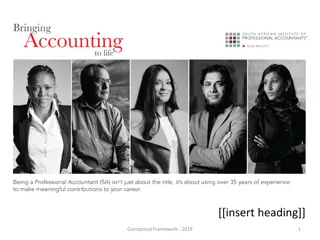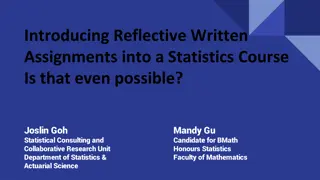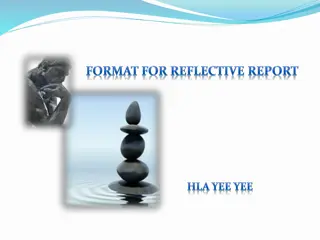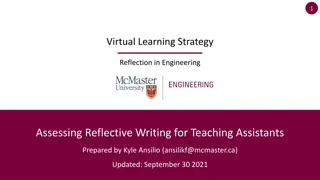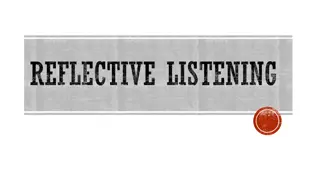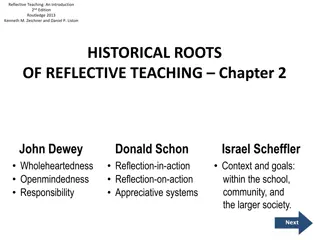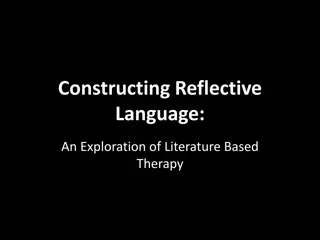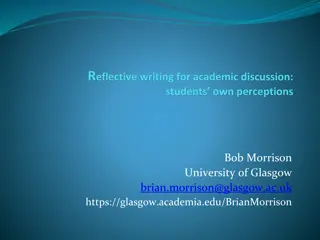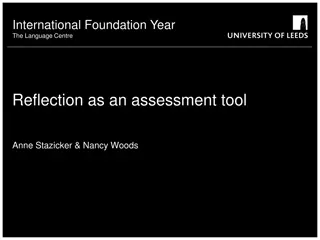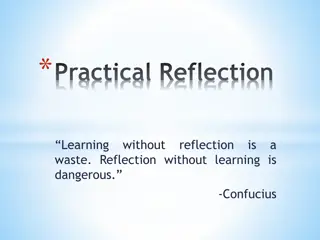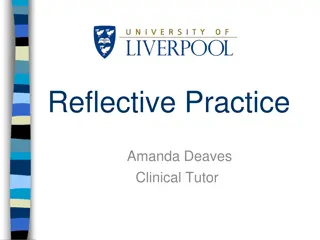Exploring Reflective Practice in Education: A Conceptual Framework
Delve into the concept of reflective practice within the field of education through the reflective practitioner framework at The Catholic University of America's Department of Education. Understand how reflective practitioners consider the consequences of educational decisions for constant refinement of the teaching and learning process. Learn about teaching reflective practice through elements of the learning environment, essential dilemmas of education, and the reflective decision-making process.
Download Presentation

Please find below an Image/Link to download the presentation.
The content on the website is provided AS IS for your information and personal use only. It may not be sold, licensed, or shared on other websites without obtaining consent from the author. Download presentation by click this link. If you encounter any issues during the download, it is possible that the publisher has removed the file from their server.
E N D
Presentation Transcript
Conceptual Framework: The Reflective Practitioner Department of Education The Catholic University of America
What is a conceptual framework? A tool that integrates philosophy with application A scaffolding device that allows more nuanced reflection and professional development
Dominant Theme of the Department of Education Conceptual Framework Reflective Practitioner A reflective practitioner considers the immediate and long-term consequences of all educational decisions with the goal of constant refinement of the teaching/learning process.
Dominant Theme of the Department of Education Conceptual Framework (2) A reflective practitioner uses reflection in, on and for practice. In: during practice, what is working and why On: after practice, what worked and why For: before practice, what should work and why
How can we teach reflective practice? There are three main pieces: elements of the learning environment essential dilemmas of education reflective decision making process
Elements of the Learning Environment: What to think about Diversityof StudentNeeds Stakeholders Personal Educational Beliefs Collaborative Assessment Classroom Practice Learner Discipline Structures Knowledge Instructional Strategies
Personal Educational Beliefs - How does one s own beliefs and value systems impact the learning environment? - What other major educational philosophies could be used to understand the teaching/learning process?
Diversity of Student Needs - How does the intellectual, emotional, social, physical development as well as cultural and spiritual needs of students affect the teaching/learning process? - What impact does a student s interest, prior knowledge, exceptionalities and learning style have on his/her learning?
Stakeholders - What people and institutions have a stake in what happens in the learning environment? - How might the needs and expectations of other stakeholders affect the learner?
Collaborative Practice - How are educational resources shared to benefit the learner? - How does educational research inform classroom decisions? Note: cooperative learning building new knowledge collaborative practice sharing resources
Discipline Knowledge - What knowledge, skills and/or dispositions was the educator trying to foster? - How did the new material fit into overall goals of learning?
Instructional Strategies - What instructional strategies were used? - What other instructional strategies might have been used? - How proficient is the teacher at implementing the chosen strategy?
Classroom Structures - How did the educator work to maximize motivation while minimizing disruptive behavior in a positive learning environment? - How did the physical environment and classroom or school policies impact the teaching/learning process?
Assessment - What assessment strategies were used? - What assessment strategies could have been used? - How effective were the chosen strategies at evaluating student achievement?
Considering the Context International Nation District/ State Community School
Educational Problems & Dilemmas - Problems - clear, if difficult, solutions - Dilemmas - values and needs in conflict with no single best answer
Reflecting on Dilemmas - Various ethically defensible positions on educational dilemmas are possible - Consider: Who should get the greatest amount of limited classroom resources: the strongest, the weakest or exactly the same for everyone? Why?
Reflecting on Dilemmas (2) - Berlak & Berlak (1981) described a method for understanding how educators chose solution strategies (essential educational questions) - Classroom decisions can be viewed in terms of a set of philosophical positions by understanding the range of possible positions it is possible to imagine other solution strategies
Grouping dilemma issues (examples) Curriculum Societal Control Should schools transmit culture or encourage change? Who controls time in class? What is important to know? Who sets standards in class? Is it more important to know or to do? How should resources be distributed? For what are schools (vs the parents vs the community) responsible? Personally meaningful or publically valued? Should childhood be different than adulthood?
Examples of Essential Question Teacher Control of Time Student Control of Time Student Control of Activities Teacher Control of Activities Whole Child Child as Student Personal Knowledge Public Knowledge
Using dilemma language to understand classroom choices C C Public C C Public St St WC WC Learner Personal Learner T T T T Control of time Personal Who should choose the books for free reading time? Control of activities Whole child vs student Public vs Personal knowledge
Decision-Making Process What to ask Philosophical Mode Interpretative Mode Reflective Practitioner Descriptive Mode
Descriptive Mode What is happening / has happened / should happen? (reflection in, on, and for practice) Not value decisions statements of fact Key questions to ask What exactly is going on? What actions and behaviors are involved? What techniques are used? What techniques could have also been used? What external pressures are shaping classroom actions?
Interpretive Mode What meaning is conveyed to the student, teacher and other stakeholders? How can misunderstanding perspectives weaken the teaching/learning process? Key questions to ask What message was sent by this decision? How do individuals and groups experience events? How did individual interpretations impact the teaching/learning process?
Philosophical Mode What is the overall purpose of the teaching/learning process in and for society? What is being valued and emphasized? Key questions to ask Is this the most worthwhile solution and for whom? Does it have merit, value? By whose criteria or philosophy? Does it recognize each learner as a unique, spiritual being? Why is it good or not good ? Is it ethical? Is it just?
Decision-Making Process Reflective practitioner (teacher, administrator, observer) is at center Each type of reflective questioning is considered a component of the decision-making process
Decision-Making Process (2) All modes must be considered, and each adds to the understanding of the previously considered components Decisions occur when starting the next cycle, regardless of where you start but process doesn t end there! ITERATIVE!
Reflective Practice Moving steadily from practice to reflection and back to improve both reflection and practice requires tools the conceptual framework is one such tool
Reflective Practice (2) Each piece (element, essential dilemmas, and decision-making process) is designed to foster reflection, NOT to determine the answer!
Reflective Practice (3) Any Questions?


